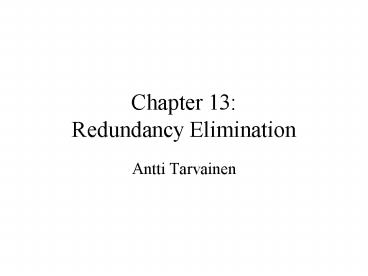Chapter 13: Redundancy Elimination - PowerPoint PPT Presentation
1 / 23
Title:
Chapter 13: Redundancy Elimination
Description:
Tries either to improve the program performance or to reduce the space it occupies ... redundancy elimination inserts and deletes computations in the flowgraph in ... – PowerPoint PPT presentation
Number of Views:118
Avg rating:3.0/5.0
Title: Chapter 13: Redundancy Elimination
1
Chapter 13Redundancy Elimination
- Antti Tarvainen
2
Redundancy Elimination
- Removes redundant computations
- Tries either to improve the program performance
or to reduce the space it occupies - Requires data-flow analysis
- Done on either medium-level intermediate code or
low-level intermediate code
3
Optimizations Covered
- Common-Subexpression Elimination
- Loop-Invariant Code Motion
- Partial-Redundancy Elimination
- Encompasses Common-Subexpression Elimination,
Loop-Invariant Code Motion and more - Code Hoisting
4
1. Common-Subexpression Elimination
5
Definition Common subexpression
- An occurrence of an expression is a common
subexpression if there is another occurrence of
the expression whose evaluation always precedes
this one in execution order and if the operands
of the expression remain unchanged between the
two evaluations
6
Common-Subexpression Elimination (CSE)
- CSE is usually done in two phases
- Local CSE is done within each basic block while
the intermediate code for the basic block is
constructed - Global CSE is done later across an entire
flowgraph representing a procedure
7
Local Common-Subexpression Elimination
- (An example, fig. 13.3 - 13.7)
8
Global Common-Subexpression Elimination
- (An example, fig. 13.8 - 13.10)
9
Global CSE with Copy Propagation
- (An example, fig. 13.12 - 13.14)
10
Forward Substitution
- Because CSE creates temporary variables to store
values of expressions, it is a trade-off between
register space and expression compactness - Sometimes we need to do it the other way around,
i.e. replace a copy operation with a reevaluation
of the expression - This is called forward substitution and is
generally easy to do
11
2. Loop-Invariant Code Motion
12
Definition Loop-Invariant Instruction
- An instruction is loop-invariant if, for each of
its operands - The operand is constant or
- All definitions that reach this use of the
operand are located outside the loop or - There is exactly one definition of the operand
that reaches the instruction and that definition
is an instruction inside the loop that is itself
loop-invariant.
13
Loop-Invariant Code Motion Example
- (An example, fig. 13.18 - 13.22)
14
3. Partial-Redundancy Elimination
15
Definition Partial Redundancy
- A partial redundancy is a computation that is
done more than once on some path through a
flowgraph. - Partial redundancy elimination inserts and
deletes computations in the flowgraph in such a
way that after the transformation each path
contains no more and, generally,
feweroccurences of any such computation than
before
16
Partial Redundancy Elimination
- Computationally optimal, i.e. after PRE the
number of computations on each program path
cannot be reduced anymore by means of safe code
motion - Made more effective by
- Critical edge splitting
- Lazy code motion
17
Critical Edge Splitting Example
- (An example, fig. 13.25)
18
Partial Redundancy Elimination Example 1
- (An example, fig. 13.26 - 13.28)
19
Partial Redundancy Elimination Example 2
- (An example, fig. 1 - 8)
- (Source Knoop, Ruthing, Steffen Lazy Code
Motion, in Proc. of SIGPLAN 92 Symp. on
Programming Language Design and Implementation
(1992))
20
4. Code Hoisting
21
Code Hoisting
- Finds expressions that are always evaluated
following some point in program and moves them to
the latest point beyond which they would always
be evaluated - These expressions are called very busy
expressions - Almost always reduces space occupied by the
program but may shorten or lengthen the execution
time
22
Code Hoisting Example
- (An example fig. 13.33 - 13.35)
23
Wrap-Up





















![Relational Database Design Chapter 8 [1 of 2] PowerPoint PPT Presentation](https://s3.amazonaws.com/images.powershow.com/7858943.th0.jpg?_=20160530039)









